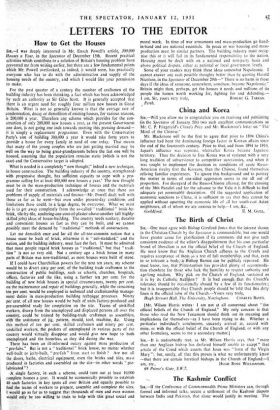LETTERS TO THE EDITOR
How to Get the Houses
Sta,-4 was deeply interested in Mr. Enoch Powell's article, 300,000 Houses a Year, in the Spectator of December 15th. Recent practical activities which contribute to a solution of Britain's housing problem have prevented me from writing earlier, but there are a few fundamental points Which Mr. Powell overlooked, as indeed, it would seem, has practically everyone wlso has to do with the administration and supply of the housing needs of the country, and which I would like your permission to make.
For the past quarter of a century the number of craftsmen of the building industry has been shrinking, a fact which has been acknowledged by such an authority as Sir Giles Scott. It is generally accepted that there is an urgent need for roughly four million new houses in Great Britain. What is not so generally known is that the average rate of condemnation, decay or demolition of existing houses, for various reasons, is 200,000 a year. Therefore any scheme which provides for the con- struction of only 200,000 now houses a year, as the present Government one does, is not going one inch towards meeting this pressing demand— it is simply a replacement programme. Even with the Conservative Party's aim of building 300,000 a year it would take forty years to Provide a house for every family in need of one today. That means that many of the young couples who are just getting married may be well on the way to being great-grandparents before the last one will be housed, assuming that the population remains static (which is not the case) and the Conservative target is adopted.
What is needed is a completely "new thought," indeed a new technique. in house construction. The building industry of the country, strengthened. with progressive thought, has sufficient capacity to cope with a pro- gramme calling for at least 400,000 new houses a year.' The new thought must be in the mass-production technique of houses and the materials used for their construction. I acknowledge at once that there are problems of supply of materials and finance—Mr. Powell dealt well with those as far as he went—but even under present-day conditions and limitations these could, to a large degree, be overcome. What we must do is to get away completely from the so-called " traditional " brick-by- brick, tile-by-tile, rendering-one-coat-of-plaster-above-another (all highly- skilled jobs) ideas of house-building. The country needs sanitary, durable and convenient houses as fast as they can be built, and we cannot possibly meet the demand by " traditional " methods of construction.
Let me demolish once and for all the all-too-common notion that a house must be built of brick, otherwise it is "sub-standard," and the nation, and the building industry, must face the fact. It must be admitted that most people regard brick houses as "traditional," but that " tradi- tion" is not so very old. Not a century ago a brick house in many parts of Britain was non-traditional, as most houses were built of stone.
If I could have Churchillian powers for the next ten years, my scheme would be to divert sixty per cent, of the building trade craftsmen to the construction of public buildings, such as schools, churches, hospitals, offices, factories and the like, using a further teu per cent. for the building of new brick houses in special circumstances, twenty per cent. on the maintenance and repair of buildings generally, while the remaining ten per cent. would be employed in technical and craftsmanship manage- ment duties in mass-production building tech9iqoe processes. Ninety per cent. of all new houses would be built of units factory-produced and pre-assembled ready for completion on the site. Teams of unskilled workers, drawp from the unemployed and displaced persons all over the country, could be trained by building-trade craftsmen as assemblers, with' the assistance of jig, pattern, mould, tool, machine, 8w. Using this method of ten per cent. skilled craftsmen and ninety per cent, unskilled workers, the pockets of unemployed in various parts of the country would virtually disappear and would give new hope to both unemployed and the homeless, as they did during the war.
There has been an ill-informed outcry against mass production of " pre-fabs." But is not a "traditional" brick house, no matter whether well-built or jerry-built, " prc-fab" from start to finish ? Are not all the doors, baths, electrical equipment, even the bricks and tiles, mass produced in factories and assembled on the site—in other words "pre- fabricated "?
A single factory, in such a scheme, could turn out at least 10,000 complete houses a year. It would be economically possible to establish 40 such factories in key spots all over Britain and equally possible to find the teams of workers to prepare, assemble and complete the sites. I would go as far as to suggest that thousands of men and even women would only be too willing to train to help with this great social and moral work. In time of war armaments and mass-production go hand- in-hand and are national essentials. In peace or war housing and mass- production must be similar partners. The building industry must recog- nise this or it will fail in its fundamental responsibility to the nation. Housing must be dealt with on a national and non-party basis and above political dispute, either at national or local government levels.
Some of your readers may think these ideas somewhat Napoleonic. I cannot answer any such, possible thoughts better than by quoting Harold Nicolson, in the Spectator of December 29th—" There is no harm in these days if the ideas of someone, somewhere, somehow, become Napoleonic." Britain might then, perhaps, get the houses it needs and millions of its people the homes worth working for, fighting for and defending,—


































 Previous page
Previous page